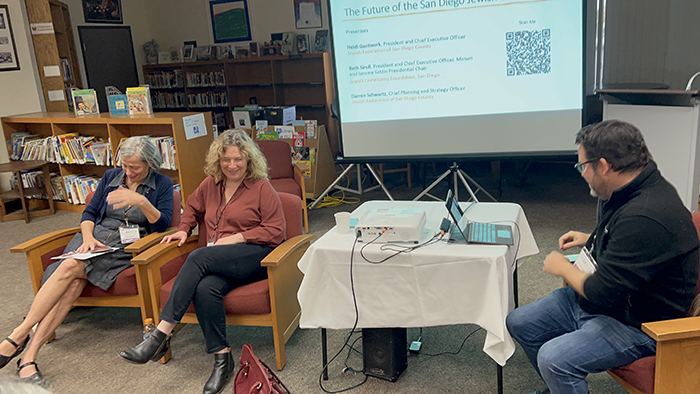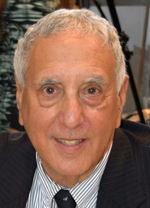
By Donald H. Harrison

SAN DIEGO – “Top line results” are expected in January from the survey of the San Diego Jewish community that was sponsored by five local agencies and was conducted by Brandies University’s Cohen Center for Modern Jewish Studies, it was announced Sunday at the Tapestry event at the Lawrence Family JCC.
That news came during a panel discussion led by the Presidents/ CEO’s of two of those agencies – Heidi Gantwerk of the Jewish Federation of San Diego County and Beth Sirull of the Jewish Foundation of San Diego County. Other sponsoring agencies of the survey are the Lawrence Family JCC, whose executive director Betzy Lynch participated in the discussion from the audience; Jewish Family Service, and the Leichtag Foundation.
Gantwerk said that a finalized report detailing the findings of the study will be issued in May or June, both in print form and at community forums, and that the findings are likely toprompt many questions concerning what San Diego County Jewry should do in response to the data.
Sirull said the survey was sent to 1500 people in random sampling of the county’s Jewish community, with different age and geographic groupings of Jews accounted for.
In commissioning the research, Sirull said, the five cooperating Jewish agencies laid out four main objectives for the Brandeis University researchers.
First, “we would gather actionable and useable data that sheds light on what Jews in San Diego think and feel,” she said. “That is to say that we not interested in a study for the sake of a study, so that we could spout some nice statistics; we really wanted to be able to use this data.
“The second guiding principle was to recognize the diversity of the Jewish community and use a really inclusive lens when we talk about who is Jewish.”
Third, she said, “we wanted to make sure that there was a full representation of Jews who are living on the margins or the fringes and who are struggling to make ends meet.”
And fourth, “we wanted to identify Jews who are feeling disconnected and disengaged with Jewish life.”
The audience at this panel was small because there were other workshops in the same time slot dealing with Israeli jewelry and art; supporting oneself and others physically, emotionally, and spiritually; Jewish humor; Jewish mindfulness, and JFest’s Best.
Gantwerk said that having five organizations participating in determining questions to be covered in the survey was tricky because generally the patience of people taking surveys lasts no more than 20 minutes, so questions needed to reflect the interests of the five organizations, yet be carefully vetted.
Survey designers needed to be particularly careful in how they phrased questions about Israel because opinions in the San Diego Jewish community are polarized, Gantwerk said. “I put a question in and one of my executive committee members called me and we had an hour-long conversation about how that was an offensive question, that phrasing it in the way we had created bad views of Israel, and why were we even asking it. These things are really difficult.” Gantwerk did not disclose what that question had asked.
Community member Marsha Sutton commented from the audience that while older members of the community have strong feelings in favor of Israel, remembering the struggles of its past, younger members of the community, particularly those for whom social justice is a priority, “are concerned about the victimization of Palestinians.”
“They don’t care about Israel at all, but the rise of antisemitism makes them feel more Jewish,” Sutton added.
A common concern in the room was that negative feelings about Israel could affect whether people—especially the younger generations–decide to identify with the Jewish community and affiliate with its institutions.
“A lot of the agencies are thinking about how to have conversations about Israel because the old ways are not working,” Gantwerk said. “We can’t continue to say, ‘Hey, they invented chips for cell phones, and cherry tomatoes; how can you have anything bad to say about this country?’ That is insufficient. Israel is complicated; it is messy. Israel is a country at a point in its history (74 years after its independence) that America was when it was [a decade before] entering the Civil War. It is messy.”
Antisemitism in America is another priority concern of Jewish policy makers. Some members of the community see Israel as an ultimate haven if antisemitism runs unchecked. Others see Israeli policies as contributing toward antisemitism. This concern has become more pronounced following the election that portends Binyamin Netanyahu’s return to power backed by far-right political parties.
Gantwerk said that “the existence of Israel makes a fundamental difference in how we talk about antisemitism. If we are not able to create the kind of conversation that enables people to understand the importance of having a Jewish homeland, and the ability to say that there are pieces of it that I don’t like, it is a challenge.”
Darren Schwartz, the Federation’s chief planning and strategy officer, commented “what this study might tell us is how we can alter how we are dealing with it (antisemitism)” and in what new ways the community can complement existing programs to combat antisemitism.
The survey will also try to identify the aspects of Jewish life that are attracting and engaging people, Schwartz said. “We are hoping to learn where the Jewish community is, where we need to go to make the future that we want.”
Sirull asked the audience “to imagine what we could do if we really knew who feels disengaged from the Jewish community and why.” She suggested that there may be communities with large Jewish populations that don’t have access to services in the community. “We really don’t know where Jews live. We assume that they live in areas where we already have services but imagine if we really knew where people are. Imagine if we knew what Jews of all ages cared about, younger and older Jews in our community. Whether Jews of color feel welcome and included by established Jewish organizations and, if not, why not? Why families with young children are struggling to keep their children engaged in Jewish life….”
*
Donald H. Harrison is editor emeritus of San Diego Jewish World. He may be contacted via donald.harrison@sdjewishworld.com